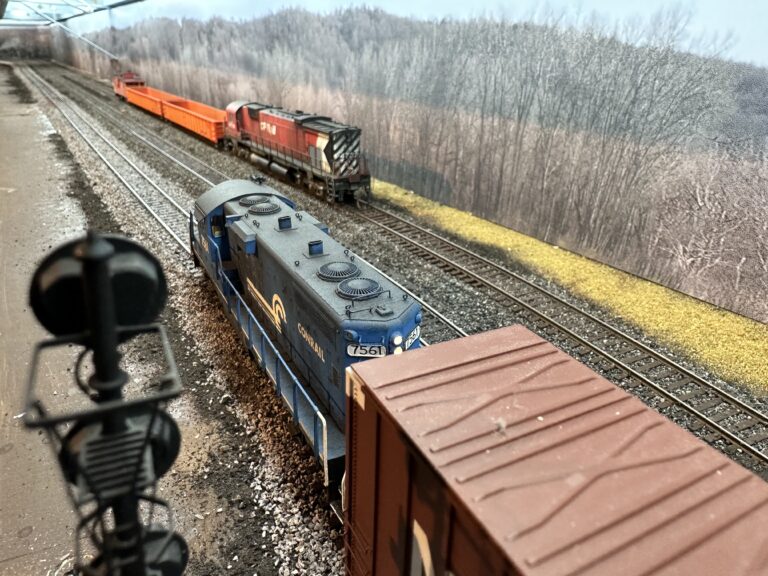We’ve lived in our house since 2012, and it didn’t take me long to set up a “temporary” layout using Kato Unitrak. This layout, called the “Aspinwall Belt” (since it’s in Aspinwall, and it went around in circles) served us well, and it was removed in 2017 to make way for basement remodeling.
Construction of the new “Lehigh Line in Bethlehem PA” began in earnest in early 2018 after the remodeling project was complete. For whatever reason, however, I haven’t really posted anything about that here. I’ve worked in fits and starts, often with months of other activities (a.k.a. “model railroad nothingness” in between. So, let’s start from the top and introduce you to the layout!
Background
Many model railroaders look to recreate childhood memories, and I’m no different: I was an avid Conrail fan ever since I was a little kid in the early 1980s, growing up in the Allentown, PA area. My mother would frequently take my brother and I down to Allentown Yard after church on Sundays, and as I got older, we’d ride our bikes there to take crappy Instamatic photos of whatever we could find. Into high school I got more serious about rail photography, started taking slides, and after I left for college I would document what I could when I visited home for breaks.
I decided to model the year 1994, specifically the “blah” of winter a.k.a. “the dead season” – with no snow on the ground. 1994 was the beginning of my senior year of high school, and represented the intersection of a few key traffic movements in Allentown, most notably being the last full year of nearby Bethlehem Steel in full operation.
Prototype Territory
The layout represents Conrail’s Lehigh Line beginning at the eastern end of Allentown Yard, continuing east through CP-JU (and connection with the former L&NE Cement Secondary), across the Lehigh River, and then east from there between the river and Bethlehem Steel’s sprawling mill. The Conrail Reading Line is represented mostly in staging, except at the diamond at-grade crossing at CP-Bethlehem. Total miles modeled isn’t going to be more than 3 or 4 miles, but this territory – especially then – was operationally dense, enough to support a sufficiently-entertaining variety of operations.
Pre-Conrail, the former Lehigh Valley line along the river was an east-west artery running from New Jersey to Buffalo. The Reading’s Philadelphia Branch terminated at Bethlehem, and the route continued across the LV and over the Lehigh River to allow Reading trains to access the Central of New Jersey’s Allentown Yard. A 1967 joint facilities agreement led to a connection between the CNJ and LV at Bethlehem as well. Starting with the 1972 retrenchment of the CNJ from PA, the Lehigh Valley took over Allentown Yard. The CNJ east of Allentown was later abandoned, and the LV west of Allentown (East Penn Jct.) largely abandoned or downgraded.
By 1994, the former LV main line was Conrail’s primary artery through the area, with some traffic flowing through Allentown Yard on the CNJ side, and some traffic staying on the Reading Line single track (“the hole”) out to Basin Street, where both routes re-converged onto former Reading territory west to Reading and from there to either Philadelphia or Harrisburg.
Traffic
The epicenter of the layout is the convergence of Conrail traffic on CP-Bethlehem, coming from 4
directions:
- Former LV single main from the west – trailer trains, coal & ore, some freight.
- Former CNJ main from Allentown Yard – freight and local
- Former LV main to the east – trailer trains, some freight & local traffic, and a bit of coal
- Former Reading Phila Branch to Saucon Yard/Bethlehem Steel – coal & ore trains
Overall, the big emphasis is on steel traffic: coal, coke, ore, and finished steel products. Manifest freight traffic will be prominent, and we will feature a few Trail-Van (TOFC) trains and a RoadRailer movement. Bethlehem Steel’s in-plant Class III shortline, the grandiosely-named Philadelphia, Bethlehem & New England, will be featured.
CP Rail had purchased the Delaware & Hudson in 1990 including the trackage rights south and east from Allentown. D&H had rights to serve Bethlehem Steel directly via Florence, D&H manifests & trailers from the north & west often ran around on the Layoff track between Bethlehem and Florence, and CP instituted trailer trains 265 & 266 to and from Oak Island (Newark, NJ).
The Layout
The layout is a triple-level shelf layout that primarily occupies a finished family room in an L configuration, with a helix at either end that connects the levels together. The bottom and middle levels are operational, and construction of the top level is limited thus far to only benchwork. Diagrams below illustrate the overall floorplan, with an emphasis on the primary viewing area in the family room. The Employee Timetable is available for download.
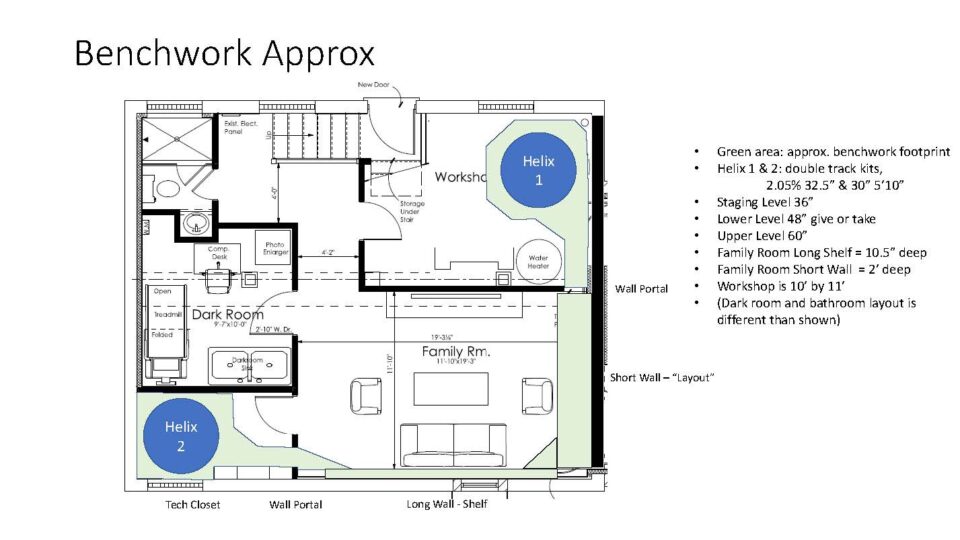
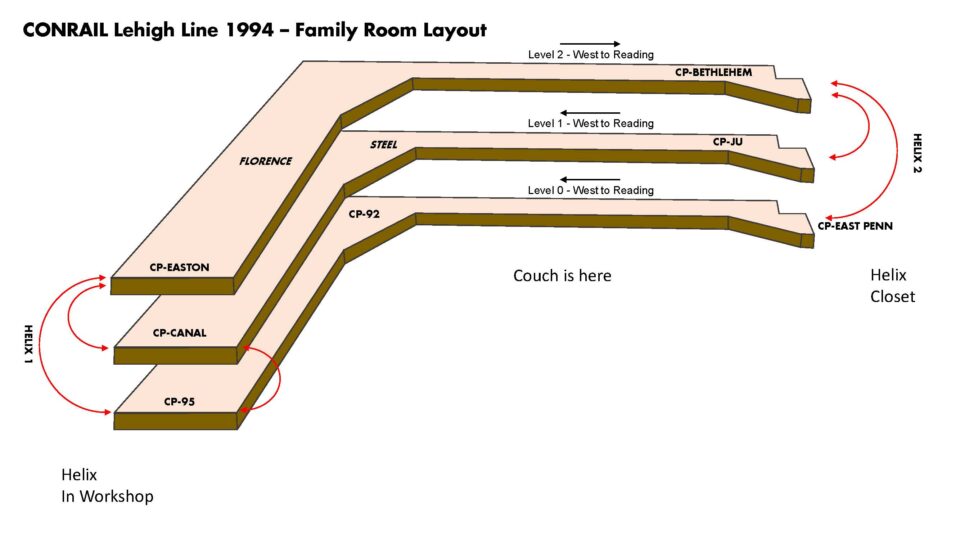
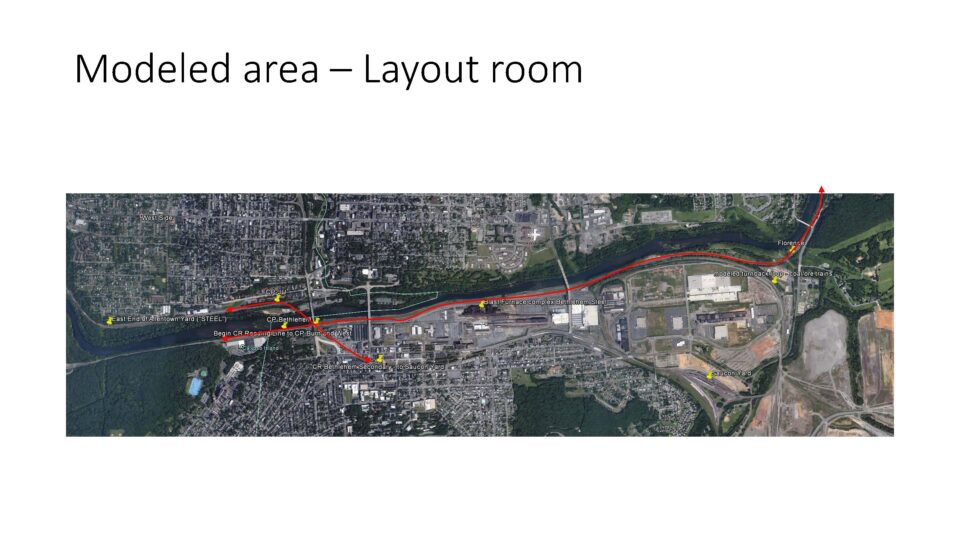
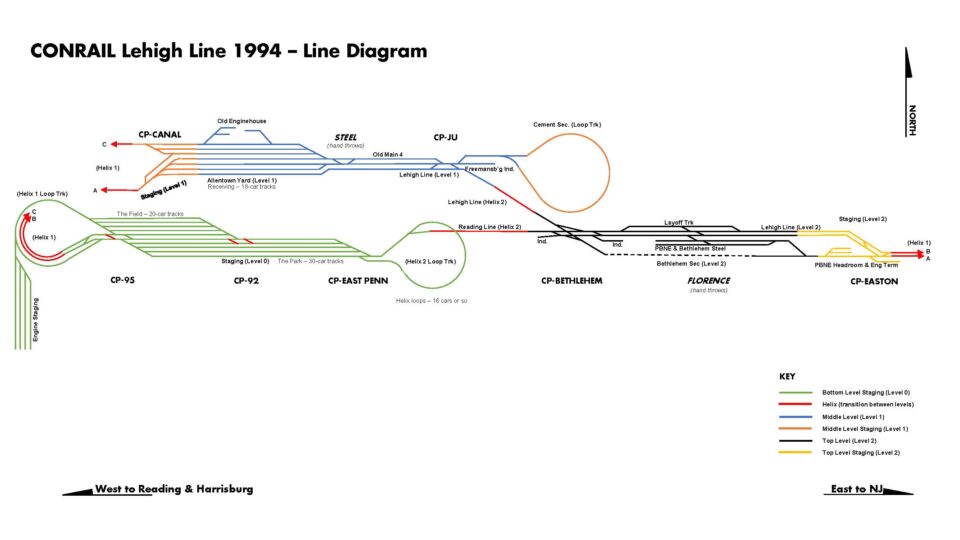
That’s it for now, we will share more soon!
